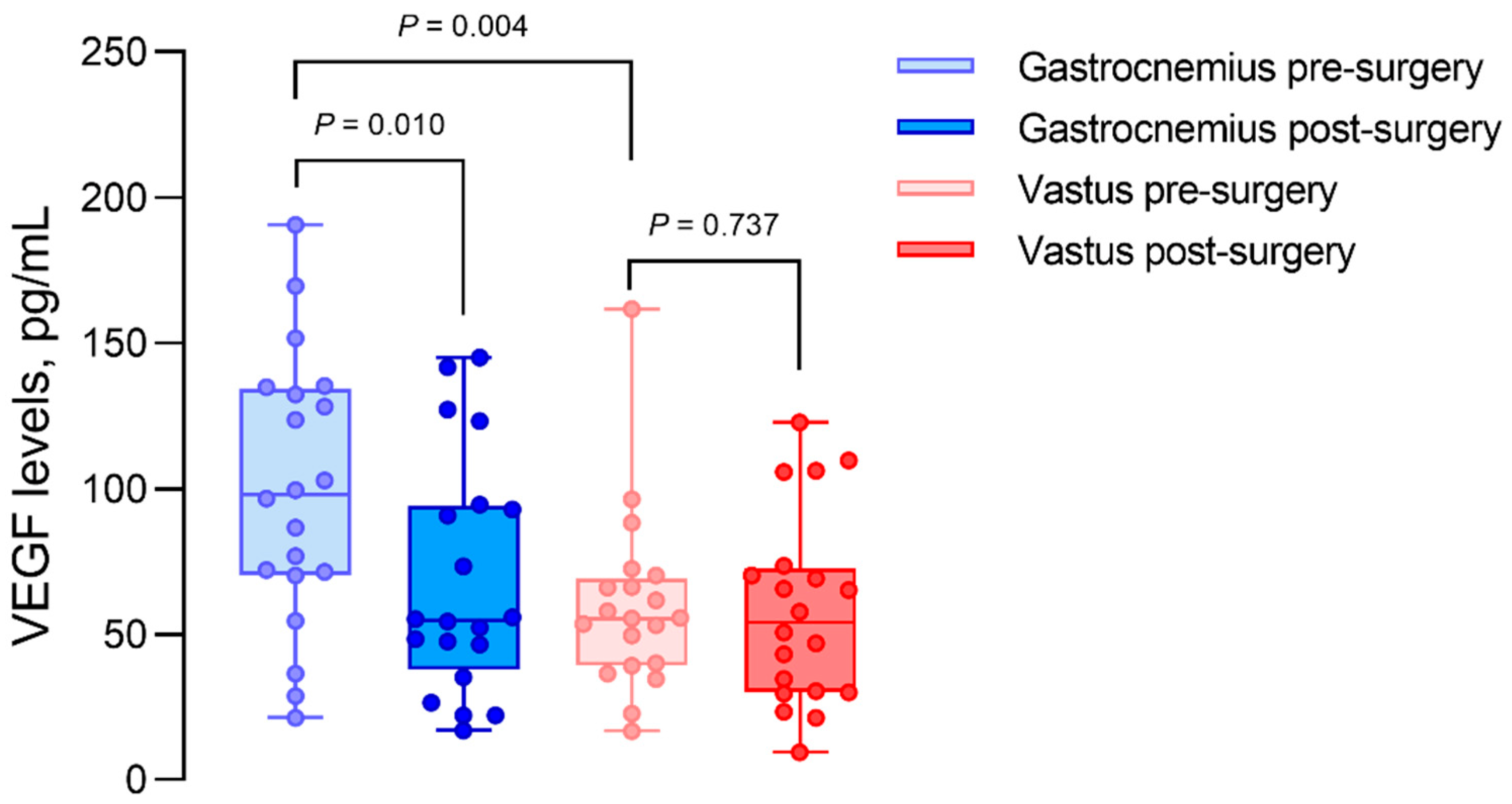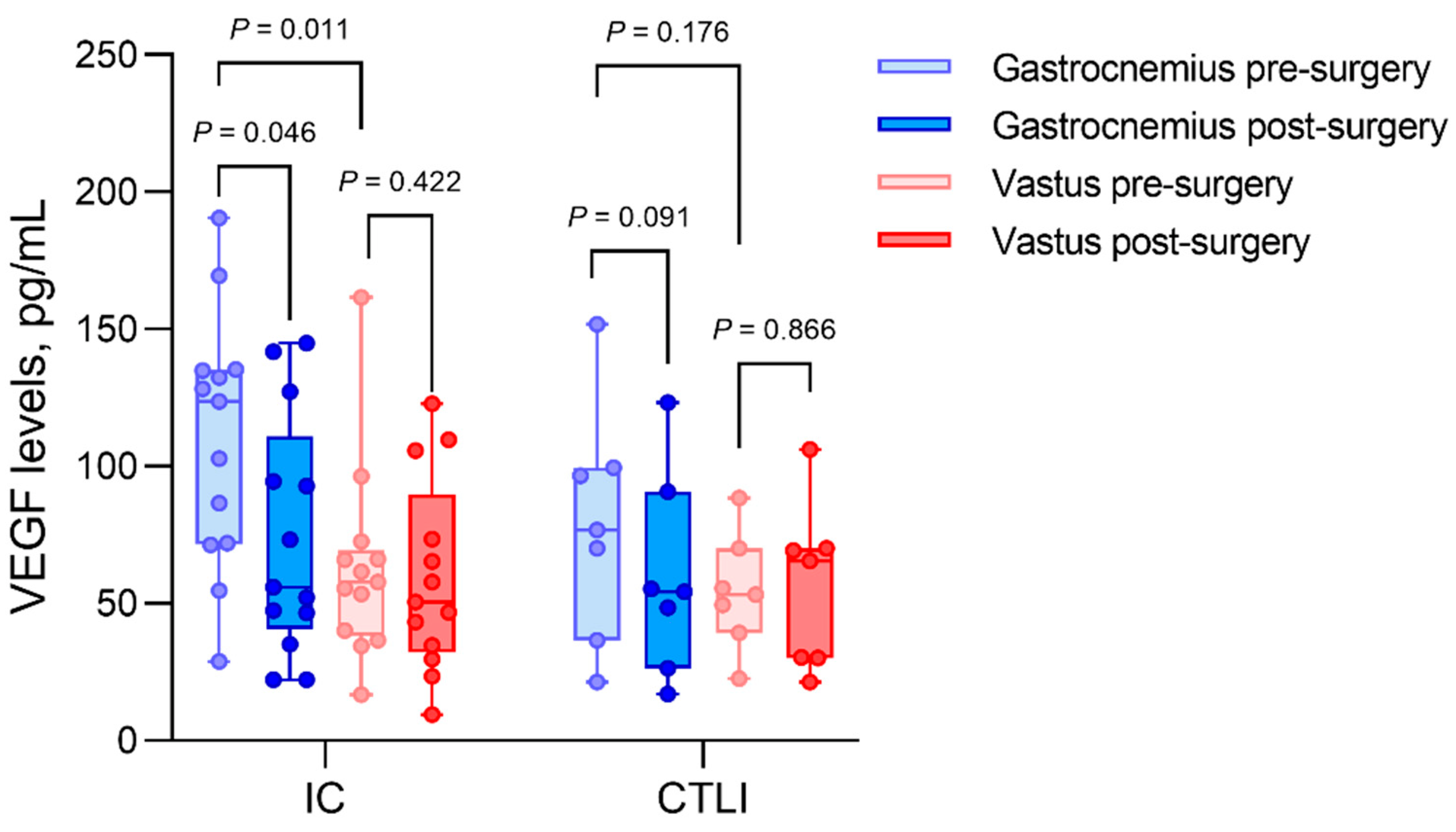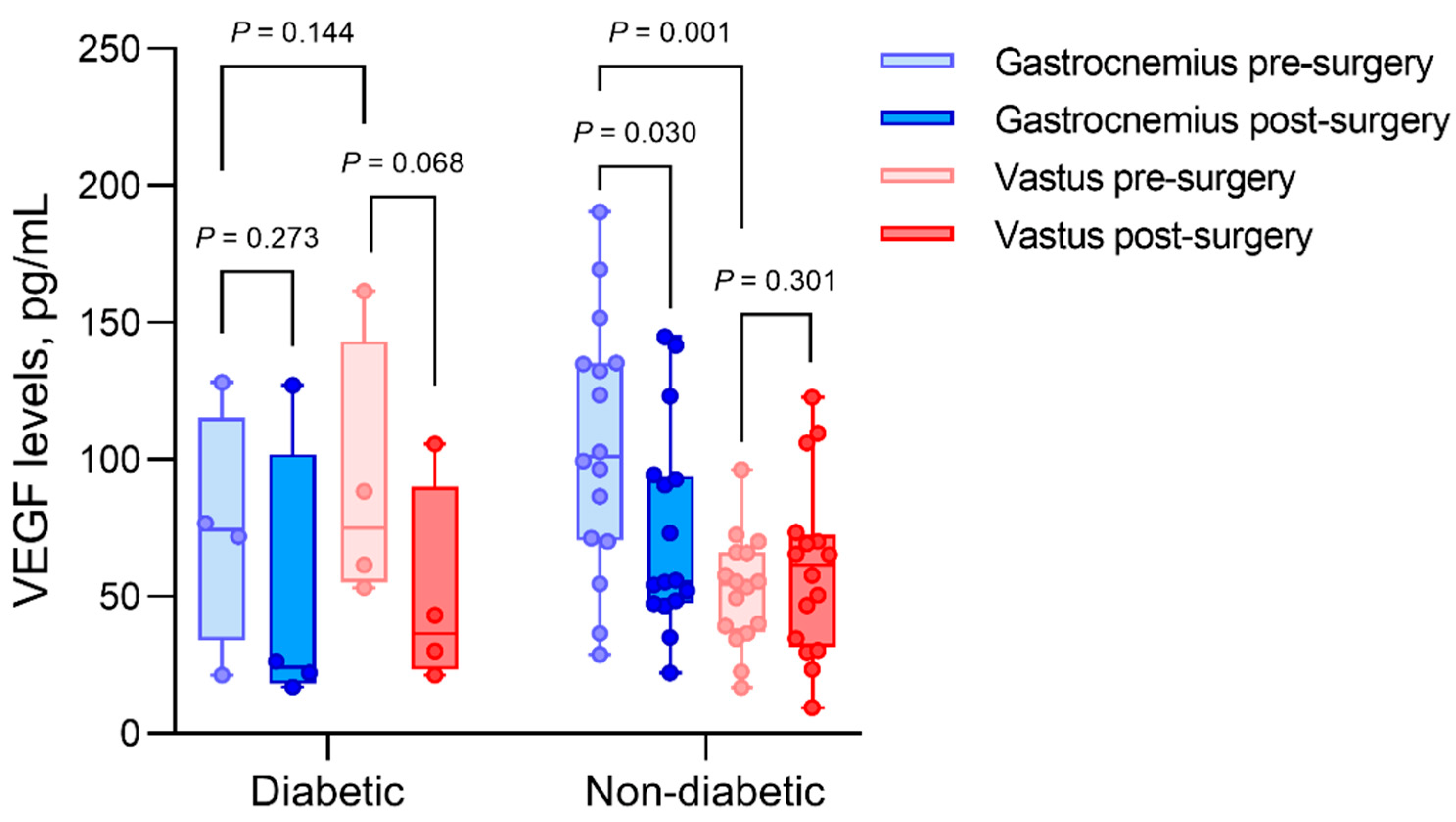Effect of Revascularization on Intramuscular Vascular Endothelial Growth Factor Levels in Peripheral Arterial Disease
Abstract
1. Introduction
2. Materials and Methods
3. Results
| n = 20 | n (%) | Median | IQR | |
|---|---|---|---|---|
| Male gender | 18 (90) | |||
| Female gender | 2 (10) | |||
| Severity of PAD | IC | 13 (65) | ||
| CLTI | 7 (35) | |||
| Diabetes | 4 (20) | |||
| Hypertension | 13 (65) | |||
| Active smoking | 11 (55) | |||
| Coronary artery heart disease | 6 (30) | |||
| Dyslipoproteinemia | 11 (55) | |||
| Chronic kidney disease (CKD) | 6 (30) | |||
| Age (years) | 66.05 | 11.90 | ||
| Body mass index (BMI) | 25.30 | 7.40 | ||
| Ankle brachial index (ABI) before revascularization | 0.66 | 0.26 | ||
| ABI after revascularization | 0.97 | 0.23 | ||
| Technique of revascularization | Open | 9 (45) | ||
| Endovascular | 2 (10) | |||
| Hybrid | 9 (45) | |||
VEGF Results
4. Discussion
5. Conclusions
Author Contributions
Funding
Institutional Review Board Statement
Informed Consent Statement
Data Availability Statement
Acknowledgments
Conflicts of Interest
References
- Morley, R.L.; Sharma, A.; Horsch, A.D.; Hinchliffe, R.J. Peripheral artery disease. BMJ 2018, 360, j5842. [Google Scholar] [CrossRef] [PubMed]
- Hamburg, N.M.; Creager, M.A. Pathophysiology of Intermittent Claudication in Peripheral Artery Disease. Circ. J. Off. J. Jpn. Circ. Soc. 2017, 81, 281–289. [Google Scholar] [CrossRef]
- Aboyans, V.; Criqui, M.H.; Abraham, P.; Allison, M.A.; Creager, M.A.; Diehm, C.; Fowkes, F.G.R.; Hiatt, W.R.; Jönsson, B.; Lacroix, P.; et al. Measurement and interpretation of the ankle-brachial index: A scientific statement from the American Heart Association. Circulation 2012, 126, 2890–2909. [Google Scholar] [CrossRef]
- Becker, F.; Robert-Ebadi, H.; Ricco, J.-B.; Setacci, C.; Cao, P.; de Donato, G.; Eckstein, H.H.; Rango, P.D.; Diehm, N.; Schmidli, J.; et al. Chapter I: Definitions, Epidemiology, Clinical Presentation and Prognosis. Eur. J. Vasc. Endovasc. Surg. 2011, 42, S4–S12. [Google Scholar] [CrossRef]
- Fowkes, F.G.R.; Aboyans, V.; Fowkes, F.J.I.; McDermott, M.M.; Sampson, U.K.A.; Criqui, M.H. Peripheral artery disease: Epidemiology and global perspectives. Nat. Rev. Cardiol. 2017, 14, 156–170. [Google Scholar] [CrossRef] [PubMed]
- Bevan, G.H.; White Solaru, K.T. Evidence-Based Medical Management of Peripheral Artery Disease. Arterioscler. Thromb. Vasc. Biol. 2020, 40, 541–553. [Google Scholar] [CrossRef] [PubMed]
- Parmenter, B.J.; Dieberg, G.; Smart, N.A. Exercise Training for Management of Peripheral Arterial Disease: A Systematic Review and Meta-Analysis. Sports Med. 2015, 45, 231–244. [Google Scholar] [CrossRef]
- Bondke Persson, A.; Buschmann, E.-E.; Lindhorst, R.; Troidl, K.; Langhoff, R.; Schulte, K.-L.; Buschmann, I. Therapeutic arteriogenesis in peripheral arterial disease: Combining intervention and passive training. VASA Z. Gefasskrankh. 2011, 40, 177–187. [Google Scholar] [CrossRef]
- Aboyans, V.; Ricco, J.-B.; Bartelink, M.-L.E.L.; Björck, M.; Brodmann, M.; Cohnert, T.; Collet, J.-P.; Czerny, M.; De Carlo, M.; Debus, S.; et al. 2017 ESC Guidelines on the Diagnosis and Treatment of Peripheral Arterial Diseases, in collaboration with the European Society for Vascular Surgery (ESVS). Eur. Heart J. 2018, 39, 763–816. [Google Scholar] [CrossRef]
- Grochot-Przeczek, A.; Dulak, J.; Jozkowicz, A. Therapeutic angiogenesis for revascularization in peripheral artery disease. Gene 2013, 525, 220–228. [Google Scholar] [CrossRef]
- Lawall, H.; Bramlage, P.; Amann, B. Treatment of peripheral arterial disease using stem and progenitor cell therapy. J. Vasc. Surg. 2011, 53, 445–453. [Google Scholar] [CrossRef]
- Heil, M.; Eitenmüller, I.; Schmitz-Rixen, T.; Schaper, W. Arteriogenesis versus angiogenesis: Similarities and differences. J. Cell. Mol. Med. 2006, 10, 45–55. [Google Scholar] [CrossRef]
- Gerritsen, M.E. Angiogenesis—Supplement 9. Handbook of Physiology, the Cardiovascular System, Microcirculation; Academic Press: New York, NY, USA, 2011. [Google Scholar]
- Hammer, A.; Steiner, S. Gene therapy for therapeutic angiogenesis in peripheral arterial disease—A systematic review and meta-analysis of randomized, controlled trials. VASA Z. Gefasskrankh. 2013, 42, 331–339. [Google Scholar] [CrossRef]
- Gratl, A.; Pesta, D.; Gruber, L.; Speichinger, F.; Raude, B.; Omran, S.; Greiner, A.; Frese, J.P. The effect of revascularization on recovery of mitochondrial respiration in peripheral artery disease: A case control study. J. Transl. Med. 2021, 19, 244. [Google Scholar] [CrossRef]
- Gavin, T.P.; Robinson, C.B.; Yeager, R.C.; England, J.A.; Nifong, L.W.; Hickner, R.C. Angiogenic growth factor response to acute systemic exercise in human skeletal muscle. J. Appl. Physiol. 2004, 96, 19–24. [Google Scholar] [CrossRef]
- Gustafsson, T.; Knutsson, A.; Puntschart, A.; Kaijser, L.; Nordqvist, A.-C.S.; Sundberg, C.J.; Jansson, E. Increased expression of vascular endothelial growth factor in human skeletal muscle in response to short-term one-legged exercise training. Pflug. Arch. 2002, 444, 752–759. [Google Scholar] [CrossRef]
- Jones, W.S.; Duscha, B.D.; Robbins, J.L.; Duggan, N.N.; Regensteiner, J.G.; Kraus, W.E.; Hiatt, W.R.; Dokun, A.O.; Annex, B.H. Alteration in angiogenic and anti-angiogenic forms of vascular endothelial growth factor-A in skeletal muscle of patients with intermittent claudication following exercise training. Vasc. Med. Lond. Engl. 2012, 17, 94–100. [Google Scholar] [CrossRef]
- Ylä-Herttuala, S.; Rissanen, T.T.; Vajanto, I.; Hartikainen, J. Vascular endothelial growth factors: Biology and current status of clinical applications in cardiovascular medicine. J. Am. Coll. Cardiol. 2007, 49, 1015–1026. [Google Scholar] [CrossRef]
- Kut, C.; Mac Gabhann, F.; Popel, A.S. Where is VEGF in the body? A meta-analysis of VEGF distribution in cancer. Br. J. Cancer 2007, 97, 978–985. [Google Scholar] [CrossRef]
- Gratl, A.; Frese, J.; Speichinger, F.; Pesta, D.; Frech, A.; Omran, S.; Greiner, A. Regeneration of Mitochondrial Function in Gastrocnemius Muscle in Peripheral Arterial Disease After Successful Revascularisation. Eur. J. Vasc. Endovasc. Surg. Off. J. Eur. Soc. Vasc. Surg. 2020, 59, 109–115. [Google Scholar] [CrossRef]
- Wieczór, R.; Wieczór, A.M.; Gadomska, G.; Stankowska, K.; Fabisiak, J.; Suppan, K.; Pulkowski, G.; Budzyński, J.; Rość, D. Overweight and obesity versus concentrations of VEGF-A, sVEGFR-1, and sVEGFR-2 in plasma of patients with lower limb chronic ischemia. J. Zhejiang Univ. Sci. B 2016, 17, 842–849. [Google Scholar] [CrossRef] [PubMed]
- Jalkanen, J.; Hautero, O.; Maksimow, M.; Jalkanen, S.; Hakovirta, H. Correlation between increasing tissue ischemia and circulating levels of angiogenic growth factors in peripheral artery disease. Cytokine 2018, 110, 24–28. [Google Scholar] [CrossRef] [PubMed]
- Findley, C.M.; Mitchell, R.G.; Duscha, B.D.; Annex, B.H.; Kontos, C.D. Plasma levels of soluble Tie2 and vascular endothelial growth factor distinguish critical limb ischemia from intermittent claudication in patients with peripheral arterial disease. J. Am. Coll. Cardiol. 2008, 52, 387–393. [Google Scholar] [CrossRef] [PubMed]
- Jazwa, A.; Florczyk, U.; Grochot-Przeczek, A.; Krist, B.; Loboda, A.; Jozkowicz, A.; Dulak, J. Limb ischemia and vessel regeneration: Is there a role for VEGF? Vascul. Pharmacol. 2016, 86, 18–30. [Google Scholar] [CrossRef] [PubMed]
- Wieczór, R.; Gadomska, G.; Ruszkowska-Ciastek, B.; Stankowska, K.; Budzyński, J.; Fabisiak, J.; Suppan, K.; Pulkowski, G.; Rość, D. Impact of type 2 diabetes on the plasma levels of vascular endothelial growth factor and its soluble receptors type 1 and type 2 in patients with peripheral arterial disease. J. Zhejiang Univ. Sci. B 2015, 16, 948–956. [Google Scholar] [CrossRef]
- Mercier, C.; Rousseau, M.; Geraldes, P. Growth Factor Deregulation and Emerging Role of Phosphatases in Diabetic Peripheral Artery Disease. Front. Cardiovasc. Med. 2020, 7, 619612. [Google Scholar] [CrossRef]
- Karayiannakis, A.; Syrigos, K.; Zbar, A.; Baibas, N.; Polychronidis, A.; Simopoulos, C.; Karatzas, G.; Karayiannakis, A.J.; Syrigos, K.N.; Zbar, A.; et al. Clinical significance of preoperative serum vascular endothelial growth factor levels in patients with colorectal cancer and the effect of tumor surgery. Surgery 2002, 131, 548–555. [Google Scholar] [CrossRef]
- Almangush, A.; Heikkinen, I.; Mäkitie, A.A.; Coletta, R.D.; Läärä, E.; Leivo, I.; Salo, T. Prognostic biomarkers for oral tongue squamous cell carcinoma: A systematic review and meta-analysis. Br. J. Cancer 2017, 117, 856–866. [Google Scholar] [CrossRef]
- Botelho, F.; Pina, F.; Lunet, N. VEGF and prostatic cancer: A systematic review. Eur. J. Cancer Prev. Off. J. Eur. Cancer Prev. Organ. ECP 2010, 19, 385–392. [Google Scholar] [CrossRef]
- Yoshitomi, Y.; Kojima, S.; Umemoto, T.; Kubo, K.; Matsumoto, Y.; Yano, M.; Sugi, T.; Kuramochi, M. Serum Hepatocyte Growth Factor in Patients with Peripheral Arterial Occlusive Disease. J. Clin. Endocrinol. Metab. 1999, 84, 2425–2428. [Google Scholar] [CrossRef][Green Version]
- Kikuchi, R.; Nakamura, K.; MacLauchlan, S.; Ngo, D.T.-M.; Shimizu, I.; Fuster, J.J.; Katanasaka, Y.; Yoshida, S.; Qiu, Y.; Yamaguchi, T.P.; et al. An anti-angiogenic isoform of VEGF-A contributes to impaired vascularization in peripheral artery disease. Nat. Med. 2014, 20, 1464–1471. [Google Scholar] [CrossRef]
- Ganta, V.C.; Choi, M.; Kutateladze, A.; Annex, B.H. VEGF165b Modulates Endothelial VEGFR1-STAT3 Signaling Pathway and Angiogenesis in Human and Experimental Peripheral Arterial Disease. Circ. Res. 2017, 120, 282–295. [Google Scholar] [CrossRef]



| VEGF (pg/mL) | Preoperative | Postoperative | p-Value | ||
|---|---|---|---|---|---|
| Median | IQR | Median | IQR | ||
| Gastrocnemius all patients | 98.07 | 61.96 | 54.83 | 49.60 | 0.010 * |
| -Gastrocnemius IC | 123.56 | 62.91 | 55.89 | 48.03 | 0.046 * |
| -Gastrocnemius CLTI | 76.83 | 44.76 | 54.37 | 35.62 | 0.091 |
| -Gastrocnemius diabetics | 74.40 | 30.36 | 24.33 | 30.73 | 0.273 |
| -Gastrocnemius nondiabetics | 101.18 | 63.93 | 55.59 | 45.11 | 0.030 * |
| Vastus all patients | 55.50 | 27.33 | 54.16 | 40.66 | 0.737 |
| -Vastus IC | 57.84 | 26.12 | 50.60 | 38.85 | 0.422 |
| -Vastus CLTI | 53.16 | 18.49 | 65.60 | 39.45 | 0.866 |
| -Vastus diabetics | 75.01 | 47.16 | 36.62 | 30.91 | 0.068 |
| -Vastus nondiabetics | 54.44 | 27.51 | 61.47 | 37.41 | 0.301 |
Publisher’s Note: MDPI stays neutral with regard to jurisdictional claims in published maps and institutional affiliations. |
© 2022 by the authors. Licensee MDPI, Basel, Switzerland. This article is an open access article distributed under the terms and conditions of the Creative Commons Attribution (CC BY) license (https://creativecommons.org/licenses/by/4.0/).
Share and Cite
Schawe, L.; Raude, B.; Carstens, J.C.; Hinterseher, I.; Hein, R.D.; Omran, S.; Berger, G.; Hering, N.A.; Buerger, M.; Greiner, A.; et al. Effect of Revascularization on Intramuscular Vascular Endothelial Growth Factor Levels in Peripheral Arterial Disease. Biomedicines 2022, 10, 471. https://doi.org/10.3390/biomedicines10020471
Schawe L, Raude B, Carstens JC, Hinterseher I, Hein RD, Omran S, Berger G, Hering NA, Buerger M, Greiner A, et al. Effect of Revascularization on Intramuscular Vascular Endothelial Growth Factor Levels in Peripheral Arterial Disease. Biomedicines. 2022; 10(2):471. https://doi.org/10.3390/biomedicines10020471
Chicago/Turabian StyleSchawe, Larissa, Ben Raude, Jan Christoph Carstens, Irene Hinterseher, Raphael Donatus Hein, Safwan Omran, Gilles Berger, Nina A. Hering, Matthias Buerger, Andreas Greiner, and et al. 2022. "Effect of Revascularization on Intramuscular Vascular Endothelial Growth Factor Levels in Peripheral Arterial Disease" Biomedicines 10, no. 2: 471. https://doi.org/10.3390/biomedicines10020471
APA StyleSchawe, L., Raude, B., Carstens, J. C., Hinterseher, I., Hein, R. D., Omran, S., Berger, G., Hering, N. A., Buerger, M., Greiner, A., & Frese, J. P. (2022). Effect of Revascularization on Intramuscular Vascular Endothelial Growth Factor Levels in Peripheral Arterial Disease. Biomedicines, 10(2), 471. https://doi.org/10.3390/biomedicines10020471






